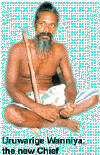|
|
||||
|
Cover Story
Art & Architecture
Archaeology
Travel
Feature
Health
Sports
Music
Lifestyle & People
South Asian Memories
|
|
|
||
|
the-south-asian.com 7 August 2000 |
||||
|
Page 2 The First People by Roopa Bakshi Uruwarige
Wanniya - the new chief of Wanniyala Aetto
The Wanniyala Aetto
‘Wann’ or ‘Vann’ means forest in Sanskrit. The
Wanniyala Aetto or the ‘forest people/beings’ had always lived in their
tropical forest in the north-eastern part of Sri Lanka. They are the
original inhabitants of this island and number about 2500 out of Sri Lanka’s
total population of 20 million. Series of Government plans and policies to
construct dams and build irrigation projects through their hunting grounds
pushed them deeper into the forest and some were compelled to be relocated
in resettlement schemes. A counter wave of settlers moved into their vacated
land to grow paddy. In 1983 the last remaining part of the forest was turned
into a National Park. The Wanniyala Aetto virtually became trespassers in
their own territory. The remaining families within the forest were evicted
and transported to an alien lifestyle – some of them even working as
showpieces for the evergrowing tourist industry. From the time their
problems first arose in 1955, the Wanniyala Aetto were guided and led by
their wisdomkeeper Uru Warige Tissahamy, who resisted all attempts to
resettle him. He led a small group of his people deeper into the forest,
proclaiming he was born in the forest and wanted to live and die there.
Tissahamy passed away two summers ago – he was believed to be 104. Almost four decades of campaigning later, the Sri Lankan
Government today has recognised the need for the indigenous people to
preserve their own identity and culture. They are being allowed, in small
numbers, to return ‘home’. The process has begun – though not without
psychological and cultural sacrifices. The Jarawa
The Jarawa are one of the four tribes in the Andamans – a group of islands [ belonging to India] in the Indian Ocean. The Jarawa are hunters and gatherers and live on the two large islands. They number between 200-400 – a large number when compared to the 28 members of ‘Great Andamanese’ tribe [near extinction as a result of their exposure to diseases such as influenza, measles and syphilis during the time that British administered the islands], and 100 Onge who work on local plantations. The ‘Sentinelese’ also number about 100. The Government had initially set aside an area for the Jarawa but the size of this reserve has gradually reduced as more of their land comes under construction for roads and settling migrants from the mainland – forcing the Jarawa deeper into the forest – into smaller areas. Contact with the migrant population has resulted in deaths from common diseases such as measles, and alcohol and tobacco addiction are on the rise. Indigenous tribes are our heritage to be treasured and it remains our responsibility to help them sustain themselves in environments they have always lived in and not turn them into objects of tourist curiosity. _____________________ the-south-asian.com wishes to acknowledge the assistance and help given by Survival UK & The Sunday Times,Sri Lanka, in providing the photographs and editorial leads for this article. |
||||
| Copyright © 2000 [the-south-asian.com]. Intellectual Property. All rights reserved. | ||||

